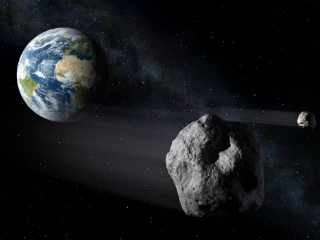NASA Astronomers Predict Near-Earth Asteroid’s 2029 Close Encounter: should we be concerned or scared?
Astronomers predict that an asteroid about the size of the Empire State Building will streak through space within 20,000 miles (32,200 km) of Earth in about 5 and a half years, the closest any celestial object of that size will have come to our planet in modern history.

When it does, a NASA spacecraft launched in 2016 is expected to provide a detailed examination of this rare close encounter.
The mission, led by scientists from the University of Arizona, is expected to yield insights into planetary formation as well as knowledge that could help build a defense system against possible doomsday asteroid collisions with Earth.
At the time of its discovery in 2004, the asteroid Apophis, named after a demon serpent representing evil and chaos in ancient Egyptian mythology, appeared to pose a serious threat to Earth, with scientists predicting a collision in 2029. Refined observations have since ruled out any risk of impact for at least the next century.
Nonetheless, the asteroid’s next approach in 2029 will bring it within a cosmic cat’s whisker of Earth — less than a tenth of the moon’s distance from us and well within the orbits of some geosynchronous Earth satellites.
Also see: SiriusXM new streaming app is set to launch next month
The spacecraft now heading for a rendezvous with Apophis is OSIRIS-REx, which made headlines three years ago when it took a soil sample from another asteroid and returned it to Earth in a capsule that parachute landed in Utah in September.
The second act of the spacecraft
Rather than retiring the spacecraft, NASA renamed it OSIRIS-APEX (Apophis Explorer) and fired its thrusters to set it on course for its next destination.
A mission overview of the Apophis expedition was published in the Planetary Science Journal.
Apophis, an oblong and somewhat peanut-shaped stony asteroid, is thought to be mostly silicate material with traces of iron and nickel. It will pass within about 19,800 miles (31,860 kilometers) of Earth’s surface on April 13, 2029, becoming visible to the naked eye for a few hours, according to Michael Nolan, deputy principal investigator for the mission at the University of Arizona.
“It’s not going to be this glorious show,” Nolan said, but it will appear as a point of reflected sunlight in the night sky over Africa and Europe.
An asteroid of that size passing so close to Earth is estimated to happen once every 7,500 years. The Apophis flyby is the first of its kind to be predicted.
Also see: The world’s largest aircraft breaks cover in Silicon Valley
The asteroid’s surface and motion will most likely be disturbed by the tidal pull of Earth’s gravity, changing its orbital path and rotational spin. Tidal forces may cause landslides on Apophis and dislodge rocks and dust particles, resulting in a comet-like tail.
The spacecraft will track the asteroid’s approach to Earth and eventually catch up with Apophis. These images and data would be combined with measurements from ground-based telescopes to detect and quantify how Apophis changed as it passed by Earth.
OSIRIS-APEX will orbit Apophis for 18 months, maneuvering around it and even hovering just above its surface, using rocket thrusters to kick up loose material and reveal what lies beneath.
Planetary science and defense
Apophis, like other asteroids, is a relic of the early solar system. Its mineralogy and chemistry have remained largely unchanged for more than 4.5 billion years, providing insights into the formation and evolution of rocky planets like Earth.
Apophis’ close examination could provide planetary defense experts with valuable information about the structure and other properties of asteroids. The more scientists understand about the composition, density, and orbital behavior of such celestial “rubble piles,” the better their chances of developing effective asteroid-deflection strategies to reduce impact threats.
Last year, NASA deliberately crashed a spacecraft into a small asteroid in a planetary-defense test, causing the rocky object to deviate from its normal path, marking the first time humans interfered with the natural motion of a celestial body.
Apophis is much larger than that asteroid, but it is nothing compared to the one that wiped out the dinosaurs 66 million years ago.
While not large enough to endanger life on Earth, an Apophis-sized asteroid striking the planet at hypersonic speed could devastate a major city or region, according to Nolan, with ocean impact causing tsunamis.
“It wouldn’t be globally catastrophic in the sense of mass extinctions,” but an impact “would definitely come under the category of bad,” Nolan said.
“This thing is coming in at many miles per second if it hits. And at that speed, it kind of doesn’t whether it’s made of gravel or ice or rocks or whatever. Nolan added, “It’s just a big, heavy thing moving fast.”

















